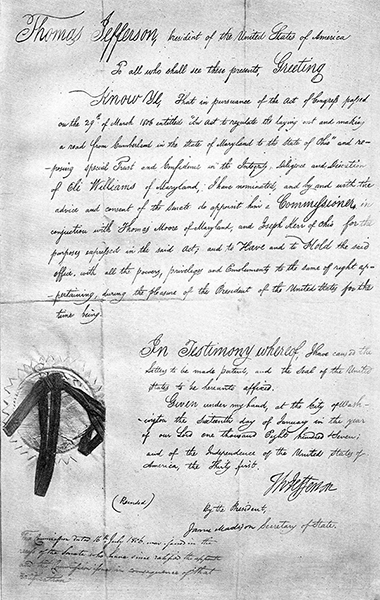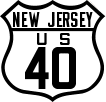For almost 800 miles west from Baltimore, Maryland to Vandalia, Illinois, the National Road served as one of the most significant predecessor roads for Route 40.
The National Road (also known as the Cumberland Road, Cumberland Pike, National Pike and Western Pike) was created by an Act of Congress in 1806 and signed by President Thomas Jefferson. The act called for a road connecting the waters of the Atlantic with those of the Ohio River. Although the Act mentions a road from Baltimore, federal funding began in Cumberland in western Maryland. Turnpike roads in Maryland connected Cumberland an Baltimore. Depending on who you ask, the National Road began in either Baltimore or Cumberland.
When the road reached Wheeling on the Ohio River, the road was extended into Ohio, Indiana and Illinois. There were plans to extend the road into Missouri, however funding ran out about the time railroads appeared.
The National Road runs from Baltimore, through western Maryland, across the southwest corner of Pennsylvania and West Virginia northern panhandle, and through Ohio, Indiana and Illinois. In western Maryland and Pennsylvania, the road roughly follows Braddock's Road. In eastern Ohio, it follows Zane's Trace. The road officially ends at the old statehouse in Vandalia, Illinois.
In the early part of this century, groups formed to promote transcontinental highways. A group was formed to promote the National Old Trails Ocean-to-Ocean highway which ran from New York City to Los Angeles. This road followed a significant portion of the National Road and other historic paths. Later, the highway's route was altered somewhat with Washington, D.C. as the starting point.
In the late 1920's, the Federal Highway System came into being and the National Road was folded into the design for U.S. Route 40. (It should be noted that the exact path of the original roads is very hard to follow in that highway construction has so drastically altered the landscape. A careful review of the roadscape, however, periodically reveals traces of the original path.) There was an attempt to make the National Road, the most historic road in America, U.S. Route 1, however doing so would corrupt the system's numbering scheme.
The first alignment of Route 40 between Baltimore and Vandalia followed the National Road. Over the years, Route 40 and the National Road have become synonymous. Even in places where Route 40 has been relocated to newer roadways, people still refer to Route 40 as the National Road.
Today, Interstate Highways 70 and 68 parallel the National Road.
No items found.
|
 |
 |
Act of Congress authorizing the National Road. Click here for a larger diaply.
|
For more information:































